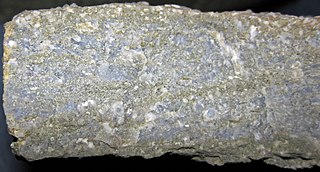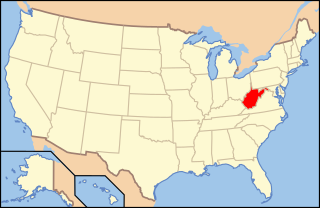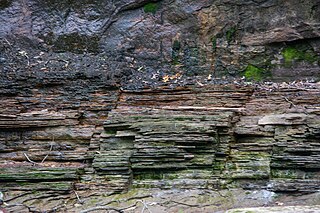Tinker's Creek, in Cuyahoga, Summit and Portage counties of Ohio, is the largest tributary of the Cuyahoga River, providing about a third of its flow into Lake Erie.

The Fort Payne Formation, or Fort Payne Chert, is a geologic formation found in the southeastern region of the United States. It is a Mississippian Period cherty limestone, that overlies the Chattanooga Shale, and underlies the St. Louis Limestone. To the north, it grades into the siltstone Borden Formation. It preserves fossils dating back to the Carboniferous period.

The Bedford Shale is a shale geologic formation in the states of Ohio, Michigan, Pennsylvania, Kentucky, West Virginia, and Virginia in the United States.

The Fayetteville Shale is a geologic formation of Mississippian age composed of tight shale within the Arkoma Basin of Arkansas and Oklahoma. It is named for the city of Fayetteville, Arkansas, and requires hydraulic fracturing to release the natural gas contained within.

Paleontology in West Virginia refers to paleontological research occurring within or conducted by people from the U.S. state of West Virginia. West Virginia's fossil record begins in the Cambrian. From that time through the rest of the early Paleozoic, the state was at least partially submerged under a shallow sea. The Paleozoic seas of West Virginia were home to creatures like corals, eurypterids, graptolites, nautiloids, and trilobites at varying times. During the Carboniferous period, the sea was replaced by lushly vegetated coastal swamps. West Virginia is an excellent source of fossil plants due to these deposits. These swamps were home to amphibians. A gap in the local rock record spans from the Permian to the end of the Cenozoic. West Virginia was never the site of glacial activity during the Ice Age, but the state was home to creatures like mammoths, mastodons, and giant ground sloths. One local ground sloth, Megalonyx jeffersonii, was subject to the scholarly investigations of Thomas Jefferson, who misinterpreted the large-clawed remains as belonging to a lion-like predator. In 2008, this species was designated the West Virginia state fossil.

The Waverly Group is a geologic group in Michigan and Ohio. It preserves fossils dating back to the Carboniferous period.

The Whitewater Formation is a geologic formation in Ohio and Indiana. It preserves fossils dating back to the Ordovician period.

The Cleveland Shale, also referred to as the Cleveland Member, is a shale geologic formation in the eastern United States.

The Chagrin Shale is a shale geologic formation in the eastern United States that is approximately 365 million years old. The Chagrin Shale is a gray shale that begins thin and deep underground in north-central Ohio. As it proceeds east, the formation thickens, rises to the surface, and contains greater amounts of siltstone.

The Warsaw Formation is a geologic formation in Illinois, Iowa and Missouri. It preserves fossils dating back to the Mississippian subperiod.
The Pennington Formation is a geologic formation named for Pennington Gap, Virginia. It can be found in outcrops along Pine Mountain and Cumberland Mountain in Kentucky, Virginia, and Tennessee, where it is the uppermost Mississippian-age formation. The name has also been applied to similar Mississippian strata in the Cumberland Escarpment of eastern Kentucky, though the rocks in that area were later renamed to the Paragon Formation.
The Java Formation is a geologic formation in Kentucky, New York, Ohio, Pennsylvania, Tennessee, Virginia, West Virginia. It preserves fossils dating back to the Devonian period. The formation comprises the Pipe Creek Shale, Wiscoy Sandstone Member in New York, and Hanover Shale Member except in Tennessee.
The Hindsville Formation, or Hindsville Limestone Member of the Batesville Formation, is a geologic unit in northern Arkansas and eastern Oklahoma that dates to the Chesterian Series of the late Mississippian. Named for the town of Hindsville in Madison County, Arkansas, this unit is recognized as a member of the Batesville Formation in Arkansas and a geologic formation in Oklahoma. Although, some workers have proposed raising the rank of this interval in Arkansas to formation status. Both the Batesville and Hindsville Formations overlie the Moorefield Formation and underlie the Fayetteville Shale.
The Imo Formation, or Imo Shale, is a geologic unit in northern Arkansas that dates to the Chesterian Series of the late Mississippian. The Imo is considered to be a member of the upper Pitkin Formation, and is the most recent Mississippian age rock in Arkansas. The Imo Shale unconformably underlies the Pennsylvanian age Hale Formation
The Moorefield Formation, or Moorefield Shale, is a geologic formation in northern Arkansas and eastern Oklahoma that dates to the Meramecian Series of the middle Mississippian. In Arkansas, this formation is generally recognized to have one member, the Ruddell Shale, in the upper Moorefield Formation.

The Bloyd Formation, or Bloyd Shale, is a geologic formation in Arkansas. It preserves fossils dating back to the Carboniferous period.
The Pitkin Formation, or Pitkin Limestone, is a fossiliferous geologic formation in northern Arkansas that dates to the Chesterian Series of the late Mississippian. This formation was first named the "Archimedes Limestone" by David Dale Owen in 1858, but was replaced in 1904. The Pitkin conformably overlies the Fayetteville Shale and unconformably underlies the Pennsylvanian-age Hale Formation. Some workers have considered the shales at the top of the Pitkin Formation to be a separate formation called the Imo Formation. More recently, others have considered the Imo to be informal member of the Pitkin Formation.
The Escabrosa Limestone is a geologic formation in Arizona left behind from an ancient sea from some 330 million years ago. Layers of the sediment left by the sea hardened into a what is called a "strata." It has preserved fossils dating back to the Mississippian subperiod.
The Albert Formation is a stratigraphic unit of Early Mississippian (Tournaisian) age in the Moncton Subbasin of southeastern New Brunswick. It was deposited in a lacustrine environment and includes fossils of fish and land plants, as well as trace fossils. It also includes significant deposits of oil shale. The oil shale beds are the source rocks for the petroleum and natural gas that has been produced from Albert Formation reservoirs at the Stoney Creek and McCully fields. In addition, the solid asphalt-like hydrocarbon albertite was mined from the Albert Formation at Albert Mines between 1854 and 1884.
The geology of Ohio formed beginning more than one billion years ago in the Proterozoic eon of the Precambrian. The igneous and metamorphic crystalline basement rock is poorly understood except through deep boreholes and does not outcrop at the surface. The basement rock is divided between the Grenville Province and Superior Province. When the Grenville Province crust collided with Proto-North America, it launched the Grenville orogeny, a major mountain building event. The Grenville mountains eroded, filling in rift basins and Ohio was flooded and periodically exposed as dry land throughout the Paleozoic. In addition to marine carbonates such as limestone and dolomite, large deposits of shale and sandstone formed as subsequent mountain building events such as the Taconic orogeny and Acadian orogeny led to additional sediment deposition. Ohio transitioned to dryland conditions in the Pennsylvanian, forming large coal swamps and the region has been dryland ever since. Until the Pleistocene glaciations erased these features, the landscape was cut with deep stream valleys, which scoured away hundreds of meters of rock leaving little trace of geologic history in the Mesozoic and Cenozoic.















